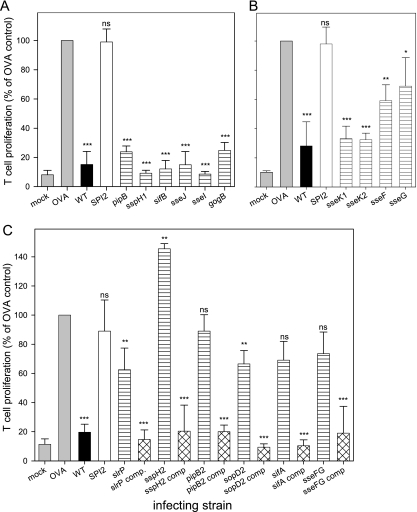FIG. 5.
Role of SPI2 effector proteins in inhibition of T-cell proliferation by intracellular Salmonella. BM-DC from BALB/c mice were infected at an MOI of 20 with Salmonella WT (▪), a strain deficient in sseC (SPI2, □), or various mutant strains deficient in genes encoding effector proteins of the SPI2-T3SS as indicated (▤). BM-DC were stimulated with 50 μg of OVA/ml in parallel with infection. For controls, uninfected BM-DC with (OVA, ░⃞) or without (mock, ░⃞) stimulation by OVA were added to T cells. T-cell proliferation was assayed by measuring [3H]thymidine incorporation and quantification of cell-bound radioactivity and is expressed as the percentage and standard deviation of the T-cell proliferation stimulated by OVA-primed DC. (A to C) Data shown are separate analyses of groups of mutant strains defective in various effectors. (C) For mutant strains that showed defects in the inhibition of antigen-dependent stimulation of T-cell proliferation, complementation experiments with plasmid-borne effectors were performed (comp, ▩). The statistical significances between the OVA-stimulated, noninfected BM-DC and the various infected assays were calculated. *, P < 0.05; **, P < 0.01; ***, P < 0.001; ns (not significant), P > 0.05.

